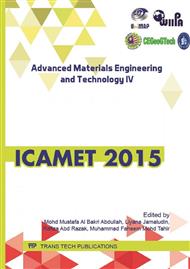p.3
p.8
p.13
p.18
p.22
p.26
p.31
p.36
Solderability and Interfacial Intermetallic Compound (IMC) Growth of Sn-Cu-Ni Solder with Additions of Germanium
Abstract:
The wettability of Sn-Cu-Ni with Germanium (Ge) additions of 0 ppm, 10 ppm, 60 ppm, 100 ppm and 200 ppm were investigated with Gen3 machine. The range of the wettability shows the lowest and the highest reading of wetting time and maximum force. Three different conditions were investigated which consist of as soldered, reflowed and aged. Further interfacial IMC observation was done for 0 ppm and 60 ppm of Ge to investigate the growth of interfacial IMC after thermal aging. From the measurement, the thickness of IMC for 0 ppm Ge is 2.075μm, 3.936μm and 4.502μm with aging time at 24,120 and 240 hours respectively. While for 60 ppm Ge, the IMC thickness are much lower with 1.8μm, 3.11μm and 4.154μm at the same aging time with 0ppm Ge. The results indicate that 60 ppm of Ge in Sn-Cu-Ni has the lowest wetting time, higher maximum force and slow IMC growth.
Info:
Periodical:
Pages:
8-12
Citation:
Online since:
May 2016
Keywords:
Price:
Сopyright:
© 2016 Trans Tech Publications Ltd. All Rights Reserved
Share:
Citation:


